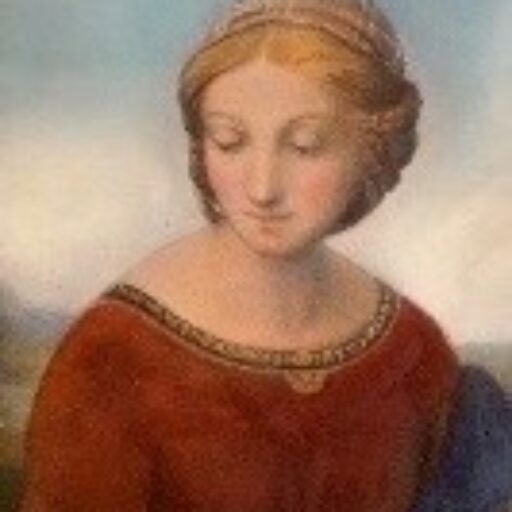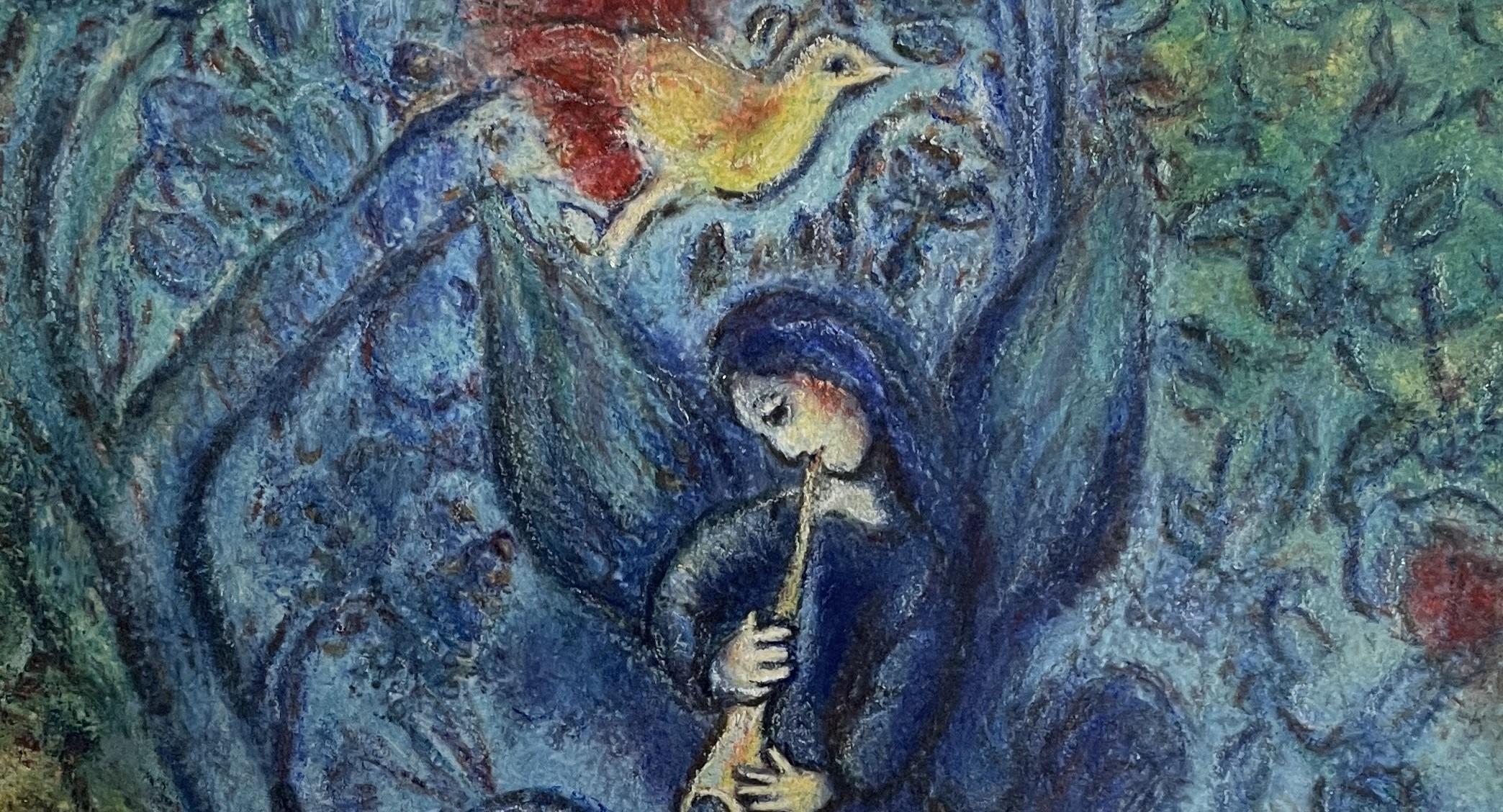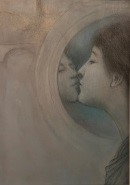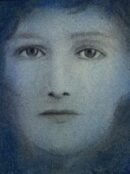日本語-Englishー台灣華語
フェルナン・クノップフ「我が心は過去に涙す 」
この絵は、グレゴワール・ル・ロアに捧げられた「我が心は過去に涙す」のいくつかあるバージョンを基に制作している。背景には彼が幼い頃に暮らしたブルージュの退廃的な景色が描かれている。クノップフの絵の特色は、色調の繊細さにある。色の移り変わりがとても微妙で再現するのが難しい。殆ど白一色で描かれた顔の輪郭と微妙な灰青色に特色がある。わずかなタッチだけで表現されているのもクノップフの絵の特色である。鏡の中で交わす接吻はナルシスティックな雰囲気を醸しだし、現実を反転させる鏡はこの世からの逃避を暗示しているかのようだ。そこからは音が聞こえてくる気配が感じられず、静粛が美を増幅している。
クノップフの描く女性はたいてい若く、きりりとした意思の強そうな顔立ちをしている。それでいてそのまなざしは物憂げで、どこか夢見るようだ。そこには生涯溺愛した妹マルグリットの面影が反映している。クノップフは短い期間を除き生涯の殆どを独身で過ごしたが、それは妹への想いからとも言われている。しかし実在する妹の写真を見る限りでは、確かに面影はあるものの、それ程美しいとは思えない。クノップフの絵にある虚ろな中にも清楚で繊細な女性像を見出すことはできない。クノップフは無垢であった妹が次第に世俗に流され、クノップフの期待を裏切って行くことに耐えられなかったに違いない。
クノップフの女性像には、彼自身が内包していた女性的な内面が、妹を通じて投影されているように感じられる。クノップフは自らの絵によって、現実世界では成し得ない男女の境界を超越した合一性を成し遂げたかったのかもしれない。そのためには他人ではない女性が必要だったのだ。同じベルギーの画家ポール・デルボーの女性像は永遠に若い自分の母親であると言われているが、クノップフの場合はきっと彼の心の中に生きている幼い頃の妹が、そのまま無垢なる成長を遂げて絵に結実しているのだと思う。
クノップフの絵は実見すると、同じベルギーの幻想画家であるデルボー、マグリット、アンソール等より、絵としての品格が上であるように私には思われる。画面には繊細な配慮が隅々まで行き渡っている。油彩の風景画はルドンと同じような深い幻想性をたたえている。クノップフは油絵ばかりでなくパステルにも優れ、更には彫刻や版画、写真まで手がけている。特に写真は彼の作品において重要な位置を占めている。クノップフは写真に対するいかなる偏見も持たず、芸術家は写真の持ち味を洗練することができると考えていた。撮影した写真にパステルで加筆してオリジナルの作品同様に署名をすることもあった。それは彼にとっては現実と幻想の中間に位置する産物なのである。
クノップフははじめ両親を喜ばせるため法律を学ぶが、次第にフランス文学の世界に傾倒し、詩人で音楽家だった弟のジョルジュとともに、本来の気質にあった芸術家の道を選ぶ。裕福でコスモポリタンな一家の御曹司として生まれたクノップフは、一時パリに住み、英国にも長期で滞在している。ペラダンの薔薇十字展やウィーンの分離派展にも出品している。フランスのモローに傾倒し、ラファエル前派のロセッティらと親交を持ち、クリムトにも影響を与えている。若くしてベルギー上流社会の人気肖像画家として生前から認められている。クノップフの美が物質主義を排した高貴な精神性を醸し出しているのは、彼の生い立ちに由来するところが大きい。クノップフは有名な「愛撫」において、男が快楽か権力かの選択に直面した場面を象徴的に描いているが、権力の愚かさを揶揄しながら、快楽の限界をも暗示している。
後年クノップフは自邸の設計に情熱を傾け、自らの殿堂である家に閉じこもることが多くなる。クノップフは敬愛するモローと同じように、自らが創り出した絵に取り囲まれて暮らすようになる。生活空間と絵画空間を一体化した生活だけがクノップフに安らぎをもたらす。クノップフの芸術が現実には何らの影響力を持ち得ることなく、時代の流れとともに滅び去って行く夢のようなものであるとしても、繊細で壊れやすいクノップフの安らぎは、自分の芸術の中にしか存在しなかったのだ。クノップフの神殿は夢のごとく彼の死後取り壊される。
My heart weeps for days of yore
This painting is based on one of several versions dedicated to Grégoire Le Roy titled “My Heart Weeps for the Past.” The background depicts the decadent landscape of Bruges where he lived as a child. The distinctive feature of Knopf’s paintings lies in the subtlety of the color tones. The transitions of color are so delicate that they are difficult to reproduce. There is a uniqueness in the almost entirely white-painted facial contours and the subtle shades of gray blue. The minimalistic touch also characterizes Knopf’s work. The kiss exchanged in the mirror emits a narcissistic atmosphere, and the mirror that inverts reality seems to hint at an escape from this world. From there, one cannot sense any sound, and the silence amplifies the beauty.
The women Knopf depicts are usually young with a strong-willed appearance, yet their gaze is melancholic, as if dreaming. This reflects the image of his sister Marguerite, whom he adored all his life. Knopf remained single for most of his life, except for a short period, which is said to be due to his feelings for his sister. However, looking at actual photos of his sister, while there is a resemblance, she does not seem particularly beautiful. It is not possible to find in Knopf’s paintings the hollow yet pure and delicate image of a woman. Knopf must have been unable to bear the sight of his sister, once innocent, being swept away by the secular world, betraying his expectations. The female figures in Knopf’s work seem to project the feminine interiority that he harbored, through his sister. Knopf might have wanted to achieve, through his paintings, a unity beyond the boundaries of gender that was not possible in the real world. For this, he needed a woman who was not another person. While the women in the works of Paul Delvaux, another Belgian painter, are said to be eternally young versions of his mother, in Knopf’s case, it is likely the sister who lived in his heart from childhood, who achieved a pure growth and culminated in his paintings.
To me, Knopf’s paintings seem to possess a higher degree of elegance than those of other Belgian fantasy painters like Delvaux, Magritte, and Ensor. The canvas is filled with delicate considerations in every corner. His oil landscape paintings embody a deep fantasy similar to that of Redon. Knopf excelled not only in oil painting but also in pastels, and even ventured into sculpture, printmaking, and photography. Especially, photography holds an important place in his works. Knopf held no prejudice against photography, believing that artists could refine the essence of photography. He sometimes added pastel to his photographs and signed them as he would his original works. For him, these were products situated between reality and fantasy.
Initially, Knopf studied law to please his parents but gradually became immersed in the world of French literature, choosing the path of an artist, which suited his true temperament, along with his brother George, who was a poet and musician. Born into a wealthy, cosmopolitan family, Knopf lived in Paris for a time and spent a long period in England. He exhibited at the Rose Croix Salon in Paris and the Vienna Secession. He was influenced by the French painter Moreau, had friendships with Pre-Raphaelites like Rossetti, and influenced Klimt. Recognized as a popular portrait painter among the Belgian upper class from a young age, Knopf’s beauty exudes a noble spirituality that rejects materialism, a reflection of his upbringing. In “The Caress,” Knopf symbolically depicted a man facing the choice between pleasure and power, mocking the foolishness of power while hinting at the limits of pleasure.
In his later years, Knopf devoted himself to designing his own home, increasingly becoming a recluse in his personal sanctuary. Like Moreau, whom he admired, Knopf lived surrounded by his own paintings. Only a life that integrated living space and painting space could bring peace to Knopf. Even if Knopf’s art had no influence on reality and was destined to vanish with the flow of time like a dream, the fragile peace of Knopf existed only within his own art. Knopf’s temple, like a dream, was demolished after his death.
費爾南・克諾普夫「我的心在過去哭泣」
這幅畫是基於獻給格雷戈瓦・勒羅亞的「我的心在過去哭泣」的幾個版本之一製作的。背景描繪了他幼年時居住的布魯日的頹廢景色。克諾普夫畫作的特色在於色調的細膩。色彩的變化非常微妙,難以再現。幾乎全白的臉部輪廓和細微的灰藍色是其特點。克諾普夫的畫作還以極少的筆觸表達,鏡中的接吻散發出自戀的氛圍,反映現實的鏡子似乎暗示著從這個世界逃避。從中感受不到任何聲音,寧靜增強了美感。
克諾普夫畫中的女性通常年輕,面容堅毅。但她們的目光卻是憂郁的,似乎在夢中。這反映了他一生深愛的妹妹瑪格麗特的影子。克諾普夫除了短暫時期外,一生大部分時間都是單身,這也被說是因為對妹妹的感情。然而,從實際存在的妹妹的照片來看,雖然有相似之處,但並不覺得美麗。克諾普夫的畫中無法找到虛無中的純潔和細膩女性形象。無疑,克諾普夫無法忍受純真的妹妹逐漸被世俗沖刷,背叛了他的期望。克諾普夫畫中的女性形象,似乎透過妹妹投射了他自己內心的女性內在。克諾普夫或許想通過自己的畫,實現現實世界中無法達成的男女界限的超越統一。因此,需要的是非他人的女性。與同為比利時畫家的保羅・德爾瓦的女性形象被認為是永遠年輕的母親不同,克諾普夫的情況下,可能是他心中活著的幼年妹妹,直接以純真的成長結晶於畫中。
克諾普夫的畫作實見時,我認為比同為比利時的幻想畫家德爾瓦、馬格利特、安索爾等的畫作更有品格。畫面中的細膩考慮到了每一處。油畫風景富含了與雷東相似的深邃幻想。克諾普夫不僅擅長油畫,也擅長粉彩,並且還涉獵雕塑、版畫和攝影。特別是攝影,在他的作品中佔有重要位置。克諾普夫對攝影沒有任何偏見,認為藝術家可以精煉攝影的特色。他也會在拍攝的照片上加以粉彩,如同原創作品一樣簽名。對他來說,這是現實與幻想之間的產物。
克諾普夫最初學習法律是為了取悅父母,但逐漸傾心於法國文學,與同為詩人和音樂家的弟弟喬治一起,選擇了更符合本性的藝術家道路。作為富裕而國際化家庭的子弟,克諾普夫一度居住在巴黎,並長期停留在英國。他參加了佩拉丹的玫瑰十字展和維也納的分離派展。他傾倒於法國的莫羅,與前拉斐爾派的羅塞蒂等人交好,也影響了克林姆特。年輕時就作為比利時上流社會的受歡迎肖像畫家而生前獲認可。克諾普夫的美學排斥物質主義,釀造出高貴的精神性,這源於他的成長背景。克諾普夫在著名的「愛撫」中象徵性地描繪了男性面臨快樂與權力選擇的場景,同時嘲笑權力的愚蠢並暗示快樂的極限。
晚年,克諾普夫對自家設計寄予熱情,越來越多地閉門不出。如同他所敬愛的莫羅一樣,克諾普夫也被自己創作的畫作所包圍。只有將生活空間和畫作空間統一的生活方式才能給予克諾普夫安寧。即使克諾普夫的藝術在現實中無法發揮任何影響力,隨著時代的流逝而消逝,那易碎的安寧僅存在於他自己的藝術之中。克諾普夫的神殿如夢般在他去世後被拆除。



